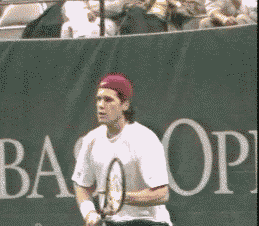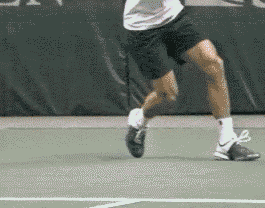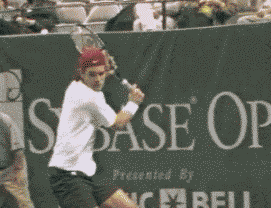Tommy Haas:
The World's Best Backhand?
By Nick Bollettieri
Tommy Haas' backhand--to me, it's the best backhand in the world today. I say that because he can do anything
with the ball; drive it, get under it and hit with topspin, hit angle shots, work the ball in rallies, and he also has a
fantastic slice.
Let's look closer at how he does it by using some of the magnificent high speed footage of Tommy developed by
John Yandell's non-profit organization, Advanced Tennis Research Project.
Preparation
Notice as Tommy starts his back swing on the backhand side, he immediately begins to change his grip, moving
from a semi-western forehand to a full eastern backhand grip. Note that the grip change is completed well before the
completion of his turn.
At the start of Tommy's motion, his shoulder is already going back. He has a big shoulder turn and the left hand goes back beautifully, automatically preparing the racquet. His arm is fairly close to his body, and I like that too.
Too many players, especially at lower levels. take the racquet back separately from the hip and shoulder
turn. This means they end up hitting the ball with the arm only. If you turn your shoulder and hips, the racquet goes back by
itself.
Because Tommy's got that hip and shoulder turn, he can get away with a half volley or hitting out of a
semi-open stance when he gets caught a little off balance or out of position.

Another interesting thing is the way Tommy Haas cocks that racquet head. He has that racquet head up above
his left shoulder and look the position of his wrists. The racquet head is directly above the hands. This is where he gets a
lot of his power.
Wide Base
Look at the wide step Tommy takes, and that is very, very important. The wide base gives him great balance
and allows him to get great lift from his legs. Here comes the racquet and here comes the step. It's almost a simultaneous
movement.
We've worked on that extensively. He lifts from the legs, not the waist. Watch how this leads to the recovery
step with the left foot coming around naturally, almost by itself.

Finishes
Tommy has a few different finishes, but he generally ends up above his right shoulder. Over the years I've taught him to relax his right hand at the end of the stroke. Many times he was too tight and too restricted.
When he hits flatter, the face of the racquet is perpendicular to the ground at the end. When he puts a little bit more spin on the ball, he is a little looser at the end with the face of the racquet coming over and closing somewhat.
Look how beautifully the left arm pulls back and that's very, very important. The right arm goes forward and straightens out and the left arm comes back.

Some coaches say the follow through is academic, but I think it has an awful lot to do with the forward part of the swing. If you end up with a longer, more relaxed follow followthrough, it does have an impact, even though people say it doesn't.
Why? The follow through determines how the racquet is traveling at the contact. If you stop directly after
contact, you'll slow down your racquet before you get to the ball.
I don't care what anybody says, the human body is not a machine that can stop in a split second. The force of
the racquet coming forward makes it impossible.
It's similar to a baseball hitter trying to check his swing because of a bad pitch. Quite often he can't, the
wrists break and they call it a swing. You can't stop the racquet the racquet, and you shouldn't try. In fact, you should do
the opposite.
Make sure you have no hesitancy on the forward part of the swing. Hit it!

A positive followthrough is especially important when you are moving backward or are a little off balance. In
this case follow through even more. Do not slow down, and that will offset the deficiency you may have with the foundation
of the stroke.
Another point. The further back you get behind the baseline, the more you should increase the clearance of
the ball going over the net, as well as the spin.
Angles
Tommy has worked hard to improve his angled backhand. Today, you have to be able to create shots, just going north and south with ground strokes isn't enough. You've got to be able to make the ball go east and west, hit the short angles, and get the ball wide before it even crosses the service line.


